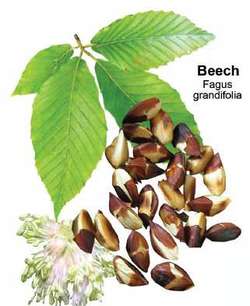beech
beech
beech
[bēch]beech, beechwood
Beech
(Fagus), a genus of monoecious plants of the family Fagaceae. Beech trees are up to 50 m in height and 2 m in diameter, with smooth, gray bark. There are ten species in the extratropical regions of the northern hemisphere; in the USSR there are three species. The leaves are deciduous, simple, usually entire, and often have hairs along the edges. Beeches blossom simultaneously with the unfolding of the leaves and are pollinated by the wind. Fruitbearing begins in 20-40 years in single-standing specimens and in 60 years or more in dense stands. The acorn-like fruits (so-called nuts) have a woody jacket and are gathered in groups of two to four in a four-lobed cupule located on a peduncle. On the outside the cupule is covered with needle-like or other types of processes; by the time the fruit ripens the cupule expands and becomes woody. Beeches are shade-tolerant, but heat-loving. In the mountains they grow at altitudes up to 2,300 m. Many beeches are valuable forest-forming and mountain-protecting species. They form pure or mixed forests and live to 400 years or more.
Beech wood is dense, heavy, and takes a high polish; it decays quickly in the open air, but in water and in moist conditions it is very durable. It is used for manufacturing musical instruments, veneers, parquet, curved furniture, methyl alcohol, and so on. The fruit contains a poisonous alkaloid, fagine, which quickly decomposes when heated; salad and industrial oils are prepared from the fruit. The oil cake is used to feed swine. Antarctic beeches belong to the genus Nothofagus.
REFERENCE
Derev’ia i kustarniki SSSR, vol. 2. Moscow-Leningrad, 1951.A. P. SHIMANIUK
